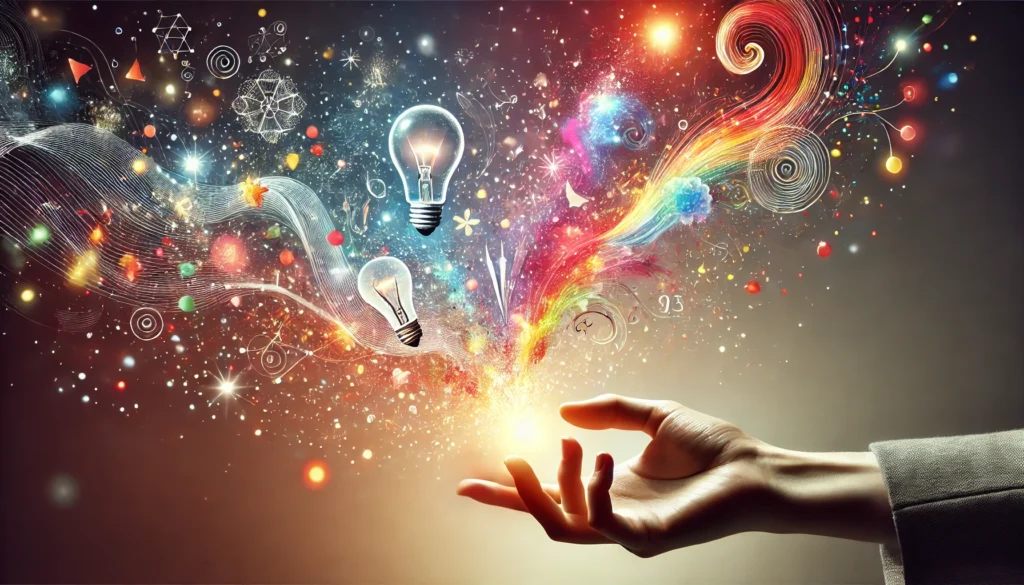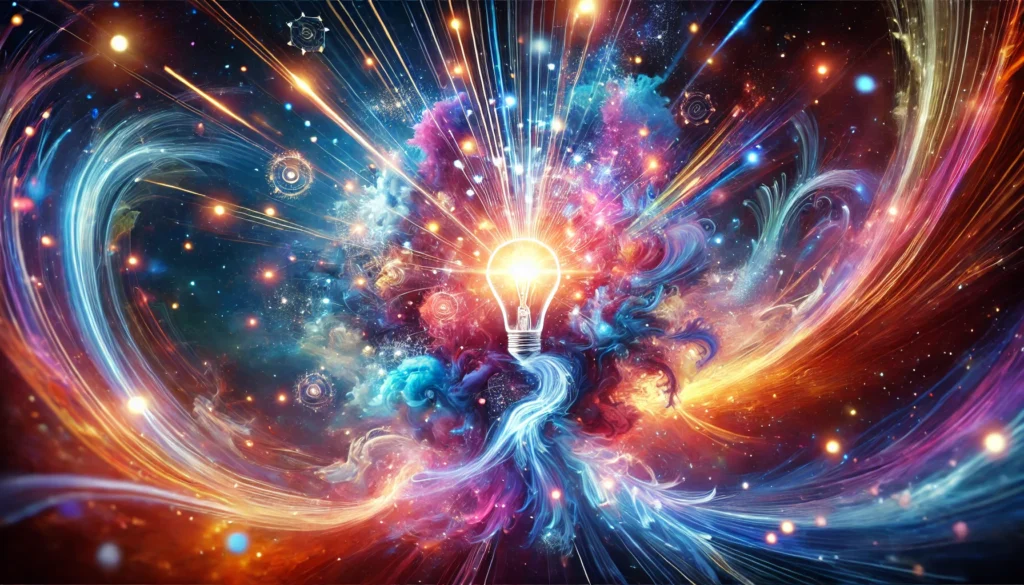To embark on this exploration, we must first define creativity. In the simplest terms, creativity is the ability to generate novel and valuable ideas. It involves divergent thinking, which is the capacity to think in varied directions and explore multiple possible solutions. This definition, however, only scratches the surface of a profoundly complex and multifaceted concept.
You may also like: Innovative Creative Thinking Techniques to Explore

Creativity as Novelty and Value
Creativity is not only about being new; it must also be valuable. Novelty alone can lead to unfeasible or impractical ideas. Therefore, the true essence of creativity lies in balancing novelty with utility. This dual characteristic ensures that creative ideas can be both groundbreaking and applicable in real-world scenarios.
Divergent and Convergent Thinking
While divergent thinking is crucial for generating ideas, convergent thinking is equally important for refining them. Divergent thinking encourages exploring many possibilities, whereas convergent thinking focuses on narrowing down options to find the best solution. Together, they form a complete creative thinking process, enabling individuals to innovate effectively.
Creativity Across Disciplines
Creativity manifests differently across various fields. In the arts, it might involve crafting a compelling narrative or painting a masterpiece. In science, it could mean formulating a new hypothesis or discovering a novel method. Each discipline harnesses creativity in unique ways, yet the underlying processes remain strikingly similar.
The Creative Process
The creative process is not a linear path but a dynamic journey that involves several stages. Graham Wallas, in his seminal work, delineated this process into four distinct phases: preparation, incubation, illumination, and verification.
1. Preparation: Laying the Groundwork
The preparation phase involves gathering information and resources. It’s a period of immersion, where one absorbs knowledge and experiences. This stage sets the foundation for creativity by equipping individuals with the necessary tools and insights to generate new ideas. Engaging with diverse sources and perspectives enriches this phase, broadening the scope for creativity.
2. Incubation: The Subconscious Brew
In the incubation phase, the mind takes a step back, allowing ideas to percolate subconsciously. This phase can occur while engaging in unrelated activities, offering the mind a chance to make connections without active effort. It often leads to unexpected insights and solutions, highlighting the importance of rest and downtime in the creative process.
3. Illumination: The Aha Moment
Illumination is when a breakthrough occurs, and an idea suddenly emerges from the subconscious to conscious awareness. This ‘aha’ moment is often described as a flash of insight that brings clarity and direction. Although it appears sudden, it results from the groundwork laid in the earlier stages, culminating in a coherent and promising idea.
4. Verification: Testing and Refining
The verification stage involves refining and validating the idea, testing its feasibility, and implementing it. This phase is crucial for transforming a creative insight into a viable solution. It requires critical thinking and practical evaluation to ensure that the idea can withstand real-world challenges and deliver tangible benefits.
Understanding these stages helps demystify the creative process, making it more accessible and manageable. By recognizing and nurturing each phase, individuals can enhance their creative potential and drive innovation.
The Importance of Creativity
Creativity is not just the domain of artists and writers; it is a crucial skill in every field. It drives problem-solving, enhances adaptability, and fosters resilience. In a rapidly changing world, creativity is the key to innovation and adaptability, enabling individuals and organizations to navigate complex challenges and seize new opportunities.
Creativity as a Problem-Solving Tool
At its core, creativity is a problem-solving tool. It allows individuals to approach issues from novel angles and devise innovative solutions. This capability is invaluable in fields ranging from engineering to education, where complex problems require creative insights to overcome obstacles and achieve progress.
Enhancing Adaptability and Resilience
Creativity enhances adaptability by encouraging flexibility in thinking and action. It empowers individuals to adjust to new situations and challenges, fostering resilience in the face of adversity. By cultivating a creative mindset, people can better navigate uncertainties and turn potential setbacks into opportunities for growth and innovation.
Creativity as a Catalyst for Innovation
The link between creativity and innovation is undeniable. While creativity refers to generating new ideas, innovation is the implementation of those ideas into practical, real-world applications. This synergy is essential for progress and growth in any industry. Creative thinking leads to breakthroughs that drive technological advancements, economic development, and social change.
For instance, in the health and wellness sector, creative thinking can lead to novel approaches to patient care, innovative health technologies, and new wellness paradigms that enhance quality of life. By fostering creativity, organizations can stay ahead of the curve and maintain a competitive edge in their respective fields.
Techniques to Foster Creativity
Creativity can be cultivated and enhanced through various techniques. Here are some strategies to nurture your creative potential:
1. Mind Mapping: Visualizing Ideas
Mind mapping is a visual tool that encourages free thinking and idea generation. It helps organize thoughts and explore connections between concepts, fostering a broader perspective. By visually representing ideas, mind mapping can uncover new relationships and pathways, sparking further creativity and innovation.
2. Brainstorming: Unleashing Idea Flow
A tried-and-true method, brainstorming involves generating as many ideas as possible without judgment. It encourages a free flow of thoughts and can be done individually or in groups. The key is to create a safe environment where all ideas are welcome, allowing participants to build on each other’s insights and push the boundaries of conventional thinking.
3. Lateral Thinking: Challenging Assumptions
Developed by Edward de Bono, lateral thinking involves approaching problems from new angles and thinking outside conventional frameworks. It challenges assumptions and encourages innovative solutions by prompting individuals to consider alternative perspectives and explore unconventional pathways. This technique can lead to groundbreaking ideas that might otherwise remain undiscovered.
4. Meditation and Mindfulness: Cultivating Clarity
Practices like meditation and mindfulness enhance focus and clarity, reducing mental clutter and fostering an open, receptive mindset conducive to creative thinking. By calming the mind and increasing awareness, these practices can help individuals tap into their innate creativity, unlocking new insights and solutions.
5. Environmental Stimuli: Inspiring Creativity
The environment plays a crucial role in fostering creativity. Surrounding oneself with inspiring stimuli, such as nature, art, or music, can stimulate the senses and spark new ideas. Creating a conducive environment that encourages exploration and curiosity can significantly enhance the creative process.

Creativity in the Context of Health and Wellness
In the realm of health and wellness, creativity plays a pivotal role. From devising personalized wellness plans to developing new therapeutic techniques, creativity is integral to enhancing well-being.
Personalized Wellness Plans: Tailoring Solutions
Health and wellness coaches can employ creative strategies to tailor personalized wellness plans that address individual needs and preferences, optimizing health outcomes. By thinking creatively, professionals can design unique interventions that consider a client’s lifestyle, goals, and challenges, resulting in more effective and sustainable health solutions.
Innovative Therapies and Techniques: Expanding Horizons
Creative thinking leads to the development of innovative therapies and techniques, such as art therapy, music therapy, and holistic wellness approaches that integrate mind, body, and spirit. These therapies offer alternative pathways to healing and well-being, providing individuals with diverse options to explore and benefit from.
Biohacking and Creativity: Unlocking Potential
For biohackers, creativity is a tool to optimize mental and physical performance. Exploring novel biohacking techniques and nootropic supplements requires an open and creative mindset to unlock new potentials. By approaching biohacking with creativity, individuals can discover unique methods to enhance their well-being and achieve their personal health goals.
The Future of Creativity
As we look to the future, the importance of creativity will only grow. With advances in technology, neuroscience, and psychology, our understanding of creativity continues to evolve. Future innovations will likely emerge at the intersection of creativity and technology, leading to breakthroughs in health, education, and industry.
Neuroscience and Creativity: Understanding the Brain
Emerging research in neuroscience is shedding light on the brain mechanisms underlying creativity, offering insights into how we can enhance and harness this vital skill. By understanding the neural processes involved, scientists and educators can develop targeted interventions to boost creativity and foster innovation across various domains.
Creativity in the Digital Age: New Possibilities
In the digital age, technology provides new platforms and tools to express and cultivate creativity, from digital art and design to online collaboration and virtual reality. These advancements offer unprecedented opportunities for creative expression and innovation, allowing individuals to explore new frontiers and connect with global audiences in ways previously unimaginable.
Creativity and Artificial Intelligence: A New Frontier
The integration of creativity and artificial intelligence (AI) presents exciting possibilities for future innovations. AI can assist in generating ideas, analyzing data, and even creating art, pushing the boundaries of what is possible. This collaboration between human creativity and machine intelligence could lead to revolutionary advancements in fields such as healthcare, education, and entertainment.
Conclusion
Creativity is an invaluable asset that transcends disciplines and industries. It is the driving force behind innovation, problem-solving, and adaptability. By understanding and nurturing creativity, we can unlock new potentials, enhance well-being, and navigate the complexities of the modern world.
Whether you’re a health and wellness coach, a science journalist, or a biohacker, embracing creativity can lead to transformative insights and solutions. As we continue to explore the essence of creativity, let us harness its power to shape a better, more innovative future. By fostering a culture of creativity, we can inspire individuals and communities to reach new heights, paving the way for a more dynamic and vibrant world.
Further Reading:
Individual qualities of creative persons
What is Creativity? The Definition, history and science of creativity
What Is Creativity, and Why Do You Need It?
Important Note: The information contained in this article is for general informational purposes only, and should not be construed as health or medical advice, nor is it intended to diagnose, prevent, treat, or cure any disease or health condition. Before embarking on any diet, fitness regimen, or program of nutritional supplementation, it is advisable to consult your healthcare professional in order to determine its safety and probable efficacy in terms of your individual state of health.
Regarding Nutritional Supplements Or Other Non-Prescription Health Products: If any nutritional supplements or other non-prescription health products are mentioned in the foregoing article, any claims or statements made about them have not been evaluated by the U.S. Food and Drug Administration, and such nutritional supplements or other health products are not intended to diagnose, treat, cure, or prevent any disease.


